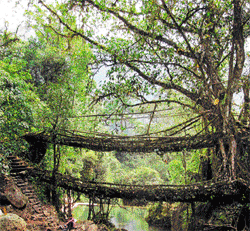
We stand on the southern edge of the plateau, looking down on Bangladesh from a height of over 800 m, as if from the parapet of a gigantic fort. The plains of Sylhet stretch out in front of us, a vast canvas in shades of green, streaked with the silver of winding streams and wetlands, the colours muted by the afternoon haze.
In the near distance, a mountain stream that has just reached the flats forms a vast sandy delta, emerging from it further on as a meandering river and forking into two. Directly below us, a road cuts through thick jungle, heading for the border village of Shella.
Satiated with the visual feast, we make our way to our guesthouse in the town now called Sohra, but certainly better known by its former name, Cherrapunjee. Sohra regained its original Khasi name a few years ago on popular local demand, but it will be a while before it gains the recognition of Cherrapunji.
Our arrival on the Sohra plateau this morning is announced by a dramatic change in the landscape. Lush green hills rifted with deep valleys give way to a vast undulating grassy plain with scant tree cover.
We stop where the road nears the edge of the plateau to marvel at the sheer granite cliffs lined with waterfalls.
A visit to the Nohkalikai Falls is the highlight of this morning. We drive past a ‘rat hole’ mine, a small tunnel dug into the side of a hillock to access the coal-bearing seam. The tunnel is not high enough to allow the average person to stand erect inside.
As we watch, a man rapidly disappears into the tunnel bent behind a wheelbarrow.
Getting closer to the western edge of the plateau, the weather turns turbulent. Clouds have suddenly appeared, blotting out the blue sky.
A thick fog completely hides the rock face where the water falls. A plaque at the site tells us about the legend of Nohkalikai.
Likai, a young woman, leaps from this cliff, grief stricken on learning that her husband has killed her daughter from an earlier marriage. ‘Noh ka Likai’ in Khasi commemorates the ‘Leap of Likai’.
We take a long walk along the plateau. The landscape is reminiscent of the English Moors, with the fog constantly shifting the limits of visibility.
When the fog lifts briefly, the Nohkalikai Falls is visible plunging into the uncertain depths. Cloud and fog accentuate the beauty of these surroundings.
We have planned a second day’s stay in the Sohra area, in a resort near the village of Laitkynsew just off the Sohra — Shella Road.
After a breakfast of suji upma made by the resort’s Khasi cook, I am ready to take on what is billed as an arduous trek to the ‘Double Decker Living Root Bridge’. Armed with stout bamboo poles we set out with Batsken, a local schoolteacher, who will be our guide.
The walk starts down a gradually sloping path that soon becomes a steep stone stairway. Where the path turns sharply, the stairway gives the impression of being suspended in space far above the green valley floor.
Near the bottom of a valley, the path is slippery with moss. The vegetation is tropical and the air humid. We cross a fast flowing stream on a makeshift bridge made with steel wire ropes that swings with each step.
Presently, we reach a second stream, its colour a striking aquamarine. Batsken informs that these are the waters from Nohkalikai Falls. The colour is due to a certain algae present in the riverbed here.
After another scary rope bridge crossing, we arrive at the village of Nongriat. A helpful sign points the way to the double decker root bridge.
A gigantic rubber tree rests on a boulder on one side of the stream. Secondary roots have been trained by the villagers to span the stream and penetrate the sloping bank on the other side. In design, the root bridge resembles the steel rope bridge with roots taking the place of steel ropes.
Rocks placed between roots have embedded themselves to offer a solid footing. The root bridge is indeed more stable than the rope bridges we crossed earlier; it does not swing. The stream has been dammed here to form a pool.
Walking towards the resort, we come across a moving plaque in the village of Tyrna. The plaque records the “loving remembrance of 100 years of shifting of the village of Tyrna”.
The old Tyrna village suffered irreparable damage in the great Assam earthquake of 1897, which had its epicentre in present-day Meghalaya, not far from where we stand.
It was one of the most powerful earthquakes ever to hit the Indian subcontinent.
The next morning, we take a farewell walk on Laitkynsew Hill to see the Sylhet plains one last time. Our precious take-away is a photo I take of a Khasi boy protectively closing his arms around his two younger sisters on seeing strangers
walking by.